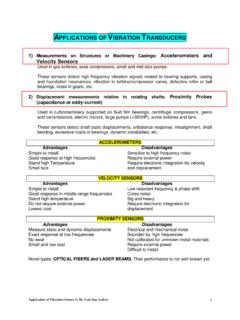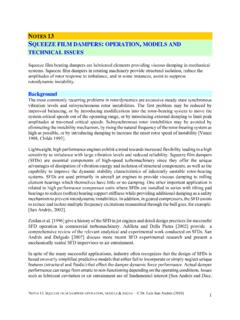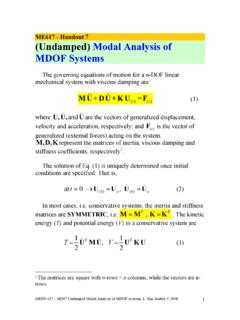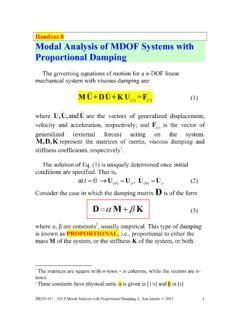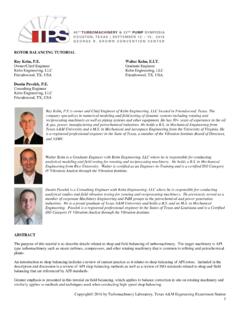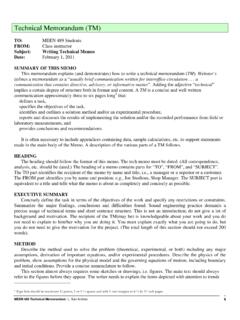Transcription of LECTURE 14: DEVELOPING THE EQUATIONS OF MOTION FOR …
1 211 LECTURE 14: DEVELOPING THE EQUATIONS OFMOTION FOR TWO-MASS VIBRATION EXAMPLESF igure a. Two-mass, linear vibration system with springconnections. b. Free-body diagrams. c. Alternative ( )( ) EQUATIONS of MOTION Assuming: The connecting spring is in tension, and the connecting spring-force magnitude is . From figure :with the resultant differential EQUATIONS : EQUATIONS of MOTION Assuming: The spring is in compression, and the connecting-spring forcemagnitude is . From figure :Rearranging these differential EQUATIONS gives Eqs.( ). 213( )Steps for obtaining the correct differential EQUATIONS ofmotion:a. Assume displaced positions for the bodies and decidewhether the connecting spring forces are in tension orcompression. b. Draw free-body diagrams that conform to the assumeddisplacement positions and their resultant reaction forces( , tension or compression).
2 C. Apply to the free body diagrams to obtain thegoverning EQUATIONS of matrix statement of Eqs.( ) isThe mass matrix is diagonal, and the stiffness matrix issymmetric. A stiffness matrix that is not symmetric and cannotbe made symmetric by multiplying one or more of its rows byconstants indicates a system that is or can be dynamicallyunstable. You have made a mistake, if in working through the214example problems, you arrive at a nonsymmetric stiffnessmatrix. Also, for a neutrally-stable system, the diagonal entriesfor the mass and stiffness matrices must be greater than center spring couples the two coordinates. If , thefollowing uncoupled EQUATIONS resultThese uncoupled EQUATIONS of MOTION can be solved separatelyusing the same procedures of the preceding ( )Figure a.
3 Two-mass, linear vibration system with motionof the left-hand support. b. Free-body diagram for assumedmotion .Base Excitation from the Left-Hand WallAssume that the left-hand wall is moving creating base excitation via . From the free-body diagram for assumedmotion ,216( )In matrix notationFigure a. Two-mass, linear vibration system with springand damper connections. b. Free-body diagram for217( )Connection with DampersAssumed MOTION conditions:a. Both m1 and m2 are moving to the right ,andb. The velocity of m2 is greater than the velocity of on this assumed MOTION , tension is developed in left andcenter dampers, but compression is developed in the rightdamper. The tension in damper 1 is , the tension in damper2 is , and the compression in damper 3 is.
4 Applying to the free body diagrams of figure :These EQUATIONS can be rearranged as 218( )In Matrix formatSimilar steps are involved in the development of EQUATIONS ofmotion for systems connected by dampers that held for springconnections; namely,a. Assume relative magnitudes for the bodies velocities and decide whether the connecting damper forces are intension or compression. b. Draw free-body diagrams that conform to the assumedvelocity conditions and their resultant damper forces ( ,tension or compression). c. Apply to the free-body diagrams to obtain thegoverning EQUATIONS of spring and damper forces can be developed Excitation via Right-hand wall motionFigure a. Coupled two-mass system with MOTION of theright-hand support defined by . b. Free-body diagramcorresponding to assumed MOTION defined by ( )Matrix StatementBase excitation causes the additional forcing functions on theright.
5 The stiffness and damping matrices should always besymmetric. If they are not, you have made a ( ) DEVELOPING the EQUATIONS of MOTION for a Double PendulumFigure Free-bodydiagram for the doublependulum of figure of MOTION for mass m1 :The second equation provides one equation in the twounknowns . 222( )( )( )( )Simple -pendulum EQUATIONS of MOTION , EQUATIONS of MOTION for mass m2:We now have two additional unknowns .Kinematics from figure :Differentiating with respect to time gives:Differentiating again gives:223( )( )( )Substituting these results into Eq.( ) gives:The second of Eq.( ) and Eqs.(134) provide three equationsfor the three unknowns . Eqs.( ) - Eqs.( ) givesEqs.( ) - Eqs.( ) gives Substituting for into thesecond of Eq.( ) gives (with a lots of algebra) :224( )This the second of the two required differential EQUATIONS .
6 Inmatrix format the model isNote that this inertia matrix is neither diagonal nor symmetric,but it can be made symmetric; , multiply the first equationby l1 and the second equation by l2. As with the stiffnessmatrix, the inertia matrix should be either symmetric, or capableof being made symmetric. Also, correct diagonal entries linearized version of this equation is obtained by assumingthat both 1 and 2 are small ( , , etc.) and can be stated225We have symmetricized the inertia matrix and now have adiagonal stiffness matrix. The inertia matrix couples these twodegrees of freedom. 226( )( ) LECTURE 15. EIGENANALYSIS FOR 2 DOF VIBRATIONEXAMPLES Thinking about solving coupled linear differential EQUATIONS byconsidering the problem of DEVELOPING a solution to thefollowing homogeneous version of Eq.
7 ( )To find a solution to the one-degree-of-freedom problem, we guessed a solution of the form. Substituting this guess nettedA nontrivial solution ( A .. 0 ) requires that .For Eq.( ) we will guessSubstituting this guessed solution gives227( )orSolving for via Cramer s rule gives:where is the determinant of the coefficient matrix. For anontrivial solution , = 0; , the coefficientmatrix must be singular. 228( )( )( )This is the characteristic equation. It is quadratic and definestwo natural frequencies versus the single naturalfrequency for the one-degree-of-freedom vibration Example:For these data, the differential Eq.( ) becomesand the frequency Eq.( ) becomeswith the solutions:229( )The first (lowest) root is the first eigenvalueand defines the first natural frequency Thenext root is the second eigenvalue and definesthe second natural frequency.
8 Solving for the coefficients. Substituting the data ofEq.( ) into Eq.( ) givesNow substituting givesThe coefficient-matrix determinant is zero, which implies thatthere is only one independent equation for the two unknowns. Hence, we can use either equation to solve for the ratios of the230( )( )two unknowns. Setting gives: Hence, the first eigenvector isMultiplying this vector by any finite constant ( positive ornegative) will yield an equally valid first eigenvector, since thevector is defined only in terms of the ratio of its components. In vibration problems, an eigenvector is also called a modeshape. Substituting into Eq.( ), netsThe matrix of eigenvectors is 231( )( )Figure illustrates the two eigenvectors. Figure Eigenvectors for the two-mass system of , with the numerical values of Eq.
9 ( ).Consider the following coordinate transformation for Eq.( )where the right vector is the vector of modal ( )( )( )( )Substituting from Eqs.( ) into Eq.( ) gives Premultiplying Eq.( ) by the transpose of gives We can now show by substitution (for this example problem)that where the modal mass matrix and modal stiffnessmatrix are diagonal. Note233( )( )The modal mass matrix is diagonal, with the first andsecond modal masses defined by .We want to normalize the eigenvectors with respect to themass matrix such that the modal mass matrix reduces tothe identity matrix [ I ]. The modal-mass coefficient for the jthmode is defined by . Dividing the jtheigenvector by will yield an eigenvector with a modalmass equal to 1, yieldingNormalizing the current eigenvector set means dividing the firstand second eigenvectors by and, respectively, obtainingYou may want to repeat calculations for this set of eigenvectorsto confirm that the modal mass matrix is now the identitymatrix.
10 Proceeding with this normalized version of theeigenvector matrix to verify that the modal stiffness matrix isdiagonal yields234( )The normalized matrix of eigenvectors yields a diagonalizedmodal stiffness matrix [ Kq ]; moreover, the diagonal entries arethe eigenvalues defined in Eq.( ); , where is the diagonal matrix of resultant modal EQUATIONS are:The transformation from modal to physical coordinates is235 Modal UnitsGiven that , and ,the units for an entry in normalized eigenvector matrix is. Hence, for the SI system, the eigenvector units are; for the USA standard unit system, the units are. From the coordinate transformation ,the units for a modal coordinate is . For the SIand USA standard systems, the appropriate units are,respectively, and . Looking at the first ofEq.
